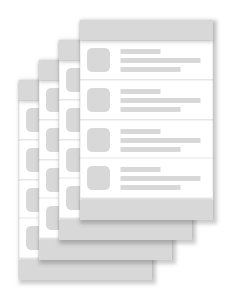ダイアログのデスティネーション
コレクションでコンテンツを整理
必要に応じて、コンテンツの保存と分類を行います。
このドキュメントでは、ダイアログのデスティネーションをどのように使用して、バックスタックの管理方法に関する独自の考慮事項を導入できるかを概説します。
概要
1 つ以上のダイアログ デスティネーションは、バックスタックの一番上だけに配置できます。これは、ユーザーがダイアログ デスティネーション以外のデスティネーションに移動すると、NavController により、すべてのダイアログ デスティネーションがスタックの一番上から自動的にポップされるためです。これにより、現在のデスティネーションが常にバックスタック上の他のデスティネーションの上に完全に表示されるようになります。
宛先には、ホストされているデスティネーション、アクティビティのデスティネーション、ダイアログのデスティネーションのいずれかを指定できます。
例
バックスタックが、ナビゲーション ホストを満たすホストされたデスティネーションのみで構成されており、ユーザーがダイアログ デスティネーションに移動した場合、バックスタックは図 2 のようになります。
 図 2. ダイアログ デスティネーションが一番上にあるバックスタック。
図 2. ダイアログ デスティネーションが一番上にあるバックスタック。
次にユーザーが別のダイアログ デスティネーションに移動すると、図 3 に示すように、バックスタックの一番上に追加されます。
 図 3. 2 つの
図 3. 2 つの Dialog デスティネーションが一番上にあるバックスタック
次にユーザーが非フローティング デスティネーションに移動すると、ダイアログ デスティネーションは、新しいデスティネーションに移動する前に、まず、図 4 に示すようにバックスタックの一番上からポップされます。
 図 4.
図 4. Dialog デスティネーションがポップされ、新しいデスティネーションが追加される
このページのコンテンツやコードサンプルは、コンテンツ ライセンスに記載のライセンスに従います。Java および OpenJDK は Oracle および関連会社の商標または登録商標です。
最終更新日 2025-07-27 UTC。
[[["わかりやすい","easyToUnderstand","thumb-up"],["問題の解決に役立った","solvedMyProblem","thumb-up"],["その他","otherUp","thumb-up"]],[["必要な情報がない","missingTheInformationINeed","thumb-down"],["複雑すぎる / 手順が多すぎる","tooComplicatedTooManySteps","thumb-down"],["最新ではない","outOfDate","thumb-down"],["翻訳に関する問題","translationIssue","thumb-down"],["サンプル / コードに問題がある","samplesCodeIssue","thumb-down"],["その他","otherDown","thumb-down"]],["最終更新日 2025-07-27 UTC。"],[],[]]




